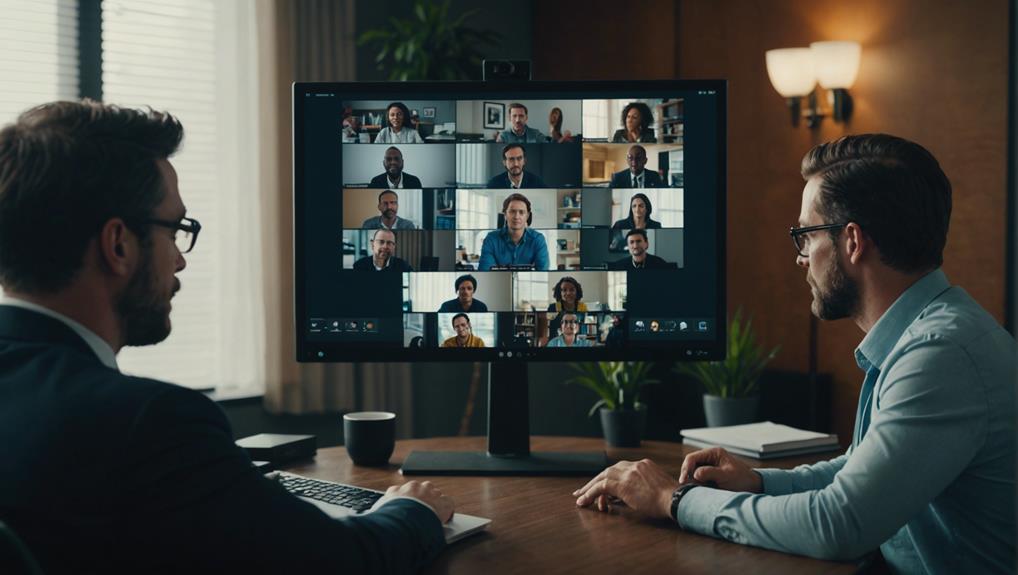Establishing Meeting Norms and Protocols for Remote Teams
When establishing meeting norms and protocols for remote teams, focus on clear communication guidelines, defined roles, and leveraging technology tools. Define communication channels, engagement expectations, and preferred methods. Encourage participation through setting clear objectives, fostering a culture of collaboration, and using icebreakers. Handle time zones effectively with tools, flexibility, shared calendars, and efficient time management. Evaluate protocols periodically, adapt based on feedback, and iterate for productivity. Establishing a strong foundation for communication and collaboration is key to driving productivity and minimizing confusion in remote teams.
Importance of Meeting Norms
Establishing clear meeting norms is essential for remote teams to guarantee effective communication, collaboration, and productivity. Consistency in how meetings are conducted ensures that everyone understands what's expected, leading to smoother interactions and better outcomes.
When team members know what to expect regarding meeting structure and etiquette, it fosters efficiency by reducing confusion and unnecessary delays. Furthermore, having established norms promotes collaboration by creating a common ground where all team members feel included and valued.
This inclusivity enhances engagement during meetings, as individuals are more likely to participate actively when they feel their contributions are appreciated and respected. By setting clear expectations regarding communication styles, participation levels, and decision-making processes, remote teams can work together more effectively towards shared goals.
Ultimately, meeting norms serve as a guiding light that helps remote teams navigate the virtual landscape with purpose and unity.
Setting Clear Expectations
To guarantee smooth collaboration within your remote team, it's essential to establish clear communication guidelines that outline how information should be shared and discussed. Defined roles and responsibilities help team members understand their tasks and contributions, fostering a sense of ownership and accountability.
Setting clear expectations also means holding individuals responsible for their actions, promoting a culture of reliability and professionalism.
Clear Communication Guidelines
Effective team communication hinges on clearly defining expectations to guarantee everyone understands their roles and responsibilities within the remote environment. In virtual settings, active listening and establishing feedback loops are essential.
Encourage team members to actively listen, ask clarifying questions, and provide constructive feedback to make certain that messages are accurately received and understood. Emphasize the importance of being mindful of nonverbal cues and following virtual etiquette to maintain professionalism and clarity in communication.
Set guidelines for written communication, such as using clear subject lines, concise messaging, and proper grammar to avoid misunderstandings. Utilize video calls when possible to enhance connection and understanding through facial expressions and body language.
Establish communication norms regarding response times, availability, and preferred communication channels to streamline interactions and avoid delays. By setting clear communication guidelines focused on active listening, feedback loops, nonverbal cues, and virtual etiquette, your team can foster a more cohesive and efficient remote work environment.
Defined Roles and Responsibilities
Establishing clear roles and responsibilities for each team member is crucial to creating a productive remote work environment. By defining specific roles, you ensure that everyone comprehends their duties and how they contribute to the team's objectives. This clarity not only improves collaboration but also instills a sense of accountability and ownership.
Effective communication plays a vital role in outlining roles and responsibilities. It is essential to openly discuss each team member's strengths, interests, and areas for growth to align tasks with individual capabilities. Encourage team members to ask questions and seek clarification to prevent misunderstandings.
Regularly revisiting and adjusting roles and responsibilities is necessary to adapt to changing project requirements or team dynamics. Flexibility is key in remote work environments, and being open to redefining roles can boost collaboration and productivity.
Encouraging open dialogue and feedback on roles and responsibilities is also important. By fostering a culture of transparency and effective communication, you establish the groundwork for a successful remote team where everyone understands their role in achieving collective success.
Accountability for Actions
Clarifying accountability for actions within your remote team involves setting clear expectations to guarantee everyone understands their responsibilities and commitments. Team accountability is vital for the success of any project. To make sure effective task ownership, it's essential to clearly define who's responsible for each aspect of a task or project. By assigning specific roles and responsibilities, team members can take ownership of their tasks and understand the impact of their actions on the overall team goals.
Setting clear expectations helps in fostering a culture of accountability within the remote team. When each team member knows what's expected of them, they're more likely to deliver on their commitments.
Regularly communicating about task ownership and progress updates can further strengthen accountability. Encouraging transparency and open communication regarding responsibilities can help prevent misunderstandings and ensure tasks are completed efficiently.
Defining Meeting Roles
Let's clarify the roles within your remote team meetings to guarantee everyone knows their responsibilities and how they contribute to the group's success. Role clarity helps in avoiding confusion and streamlining decision-making processes during virtual meetings.
Aligning responsibilities with team members' strengths can boost productivity and overall meeting effectiveness.
Role Clarity
Defining meeting roles within your remote team is crucial for guaranteeing clarity and efficiency in your virtual meetings. Role clarity helps establish clear expectations, enhances team dynamics, and promotes effective communication.
By assigning specific roles such as facilitator, timekeeper, note-taker, and participants, each team member gains a sense of task ownership and responsibility. This division of roles not only streamlines meeting processes but also fosters team collaboration by ensuring that everyone has a defined purpose during the meeting.
In remote settings, where visual cues and in-person interactions are limited, role clarity becomes even more critical. Clearly defining who's responsible for what tasks helps prevent confusion, minimizes overlaps, and ensures that meetings run smoothly.
It also encourages active participation from all team members, as each person understands their role in contributing to the meeting's objectives. By establishing and reinforcing role clarity, you create a foundation for effective team collaboration and successful virtual meetings.
Responsibilities Alignment
Assigning specific meeting roles to team members is crucial for guaranteeing responsibilities alignment and effective collaboration in virtual meetings. To achieve this alignment, start by providing a responsibilities overview to each team member. Clearly outline what's expected of them during the meeting, whether it be leading discussions, taking notes, or keeping track of time. This clarity helps team members understand their individual contributions to the meeting's success.
In addition to the responsibilities overview, consider using alignment checklists. These checklists can serve as a quick reference guide for team members, outlining their roles and tasks for easy reference during the meeting. By having these checklists readily available, team members can stay focused on their responsibilities and ensure that all necessary tasks are completed.
Encouraging open communication and transparency about roles within the team fosters a collaborative environment where everyone understands their responsibilities and can work together seamlessly. By defining meeting roles clearly through responsibilities alignment, you set your team up for productive and efficient virtual meetings.
Leveraging Technology Tools
To enhance collaboration and efficiency within your remote team, explore the various technology tools available to streamline communication and workflow processes.
Virtual collaboration tools such as video conferencing platforms like Zoom or Microsoft Teams can facilitate face-to-face interactions, making meetings more engaging and productive. These platforms enable screen sharing, chat features, and virtual whiteboards, enhancing teamwork even from different locations.
Tech integration tools like project management systems such as Asana or Trello help in assigning tasks, setting deadlines, and tracking progress transparently. These tools centralize project information, ensuring that everyone is on the same page and aware of their responsibilities.
Additionally, cloud storage services like Google Drive or Dropbox allow for easy sharing and access to documents, fostering collaboration seamlessly.
Establishing Communication Guidelines
When setting up communication guidelines for your remote team, establishing clear expectations and preferred methods of communication is vital to guaranteeing efficient and effective collaboration. Team dynamics play a critical role in remote collaboration, making it imperative to outline how communication will flow within the team.
Clearly define which communication channels to use for different purposes – whether it's email for formal updates, instant messaging for quick queries, or video calls for virtual meetings. By setting these guidelines, you create a structured approach that enhances productivity and minimizes misunderstandings.
Virtual meetings are a cornerstone of remote teamwork, necessitating specific communication strategies. Ensure that all team members are familiar with the virtual meeting platform and its features to facilitate smooth interactions. Encourage active participation by setting expectations for engagement during meetings, such as encouraging questions or feedback.
Establishing communication guidelines that cater to your team's dynamics and the nature of virtual collaboration will foster a cohesive and connected remote team.
Encouraging Participation and Engagement
Encourage active involvement and collaboration within your remote team by fostering a culture of participation and engagement during virtual meetings. Boosting motivation is essential for team members to feel invested in the discussions. Begin by setting clear objectives for each meeting, outlining the purpose and expected outcomes. This helps create a sense of direction and encourages team members to actively contribute towards achieving the goals.
Fostering connection among team members is key to enhancing collaboration. Encourage open communication and feedback to create a supportive environment where everyone feels valued and heard. Consider utilizing icebreakers or team-building activities at the start of meetings to break the ice and strengthen relationships.
Improving engagement can be achieved by promoting interactive discussions and involving all team members in decision-making processes. Encourage individuals to share their thoughts, ask questions, and provide input on relevant topics. Acknowledge and appreciate contributions to show that each team member's perspective is valued.
Handling Time Zones Effectively
Managing time zone differences efficiently is essential for remote teams to guarantee seamless communication and coordination across locations. Effective time management and scheduling efficiency are critical in ensuring that team members from various regions can collaborate without unnecessary delays.
When scheduling meetings, consider using tools like World Time Buddy to find mutually convenient times for everyone. By proactively addressing time zone challenges, you can streamline global collaboration and bridge gaps between team members, ultimately enhancing productivity and teamwork.
Encourage all team members to be flexible in adjusting their schedules occasionally to accommodate colleagues in different time zones. Additionally, establishing a shared calendar that displays everyone's working hours can aid in promoting transparency and understanding across the team.
Evaluating and Adjusting Protocols
To optimize the effectiveness of your remote team's operations, it's important to regularly review and adapt protocols to guarantee they align with current needs and challenges. Revisiting expectations and adapting processes can greatly enhance your team's efficiency and overall performance.
Begin by scheduling periodic evaluations to assess the relevance and efficacy of existing protocols. Encourage team members to provide feedback based on their experiences and suggest any necessary adjustments.
When evaluating protocols, consider factors such as communication effectiveness, meeting structures, decision-making processes, and task allocation methods. Identify areas where protocols may be causing bottlenecks or confusion and prioritize modifications to address these issues promptly.
Additionally, stay attuned to feedback regarding the clarity of expectations and the alignment of protocols with the team's goals.
Remember that adapting processes is a continuous endeavor. As your team evolves and encounters new challenges, be prepared to iterate on protocols to make sure they remain conducive to productivity and collaboration.
Conclusion
To sum up, establishing meeting norms and protocols for remote teams is essential for effective communication and collaboration. By setting clear expectations, defining roles, leveraging technology tools, and encouraging participation, teams can work together seamlessly despite distance.
For example, a recent study found that teams who implemented communication guidelines and actively engaged in virtual meetings saw a significant increase in productivity and satisfaction.
Remember, successful remote teamwork starts with well-established meeting protocols.







